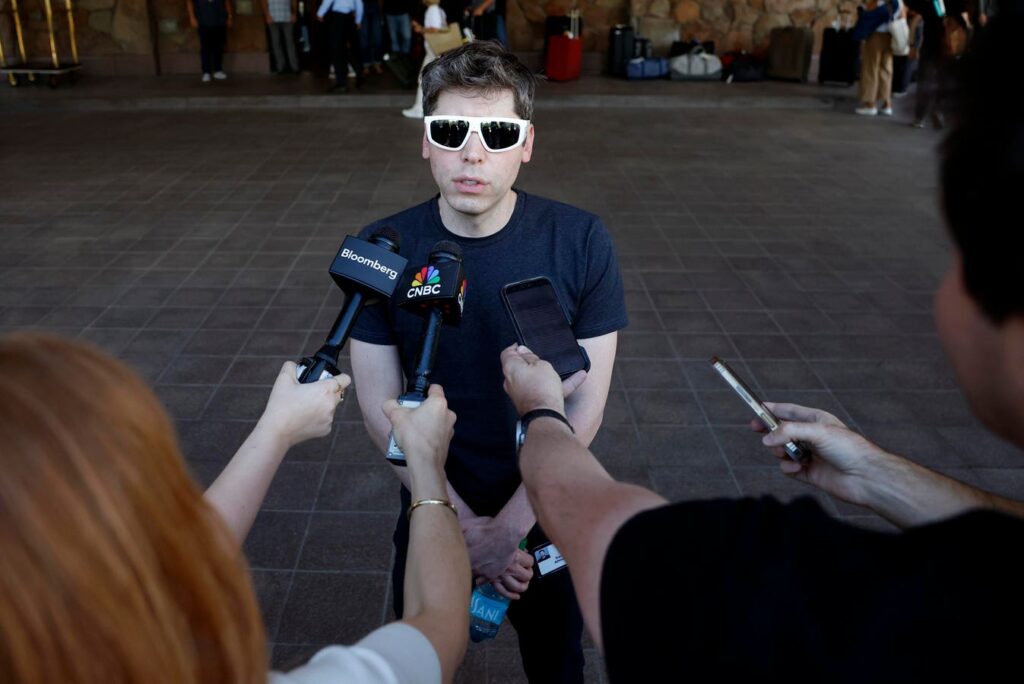“When bubbles happen, smart people get overexcited about a kernel of truth,” OpenAI CEO Sam Altman said.
Getty Images
Markets are soaring. Valuations are swelling. And enthusiasm for all things artificial intelligence is pumping hundreds of billions of dollars into the most transformational technology of the modern era.
“AI isn’t just another theme; it’s the culmination of decades of evolution in computing,” Jon Markman, a Forbes contributor who analyzes tech stocks, writes. “Every layer of the stack, from power generation to semiconductors to enterprise software, is being rebuilt for an AI-first world. That’s a structural transformation.”
Is this growth sustainable or another bubble about to burst, potentially wiping out $40 trillion of value from the Nasdaq and washing away upstart AI companies faster than they sprouted?
Forbes expert contributors have been on AI-bubble watch for months, tracking reliable signs of stability while warning about soft spots that echo the dot-com crash a generation ago.
“I see three scenarios,” Forbes senior markets contributor Peter Cohan says. “GenAI keeps booming, there’s a soft-landing in which valuations decline somewhat, and the OpenAI bankruptcy scenario, which brings it all down abruptly should the company be unable to raise more capital to fund its money-losing operations.”
Indeed, OpenAI, the most recognizable brand name in artificial intelligence, has become a symbol and driver of the boom.
Every megadeal OpenAI strikes — with AMD, Broadcom, Nvidia, Oracle and even Walmart — adds another billion-dollar brick to the AI foundation or inflates the potential bubble even more. Anxiety is growing while investor consensus ranges from cautiously optimistic to defiantly bullish.
OpenAI co-founder and CEO Sam Altman has struck deals with other AI economy behemoths, including Nvidia, Oracle and AMD.
Getty Images
Inside The New AI Economy
Forbes contributor and big-tech veteran Sol Rashidi points to “OpenAI’s ambitions to vertically integrate compute, data, and model training at unprecedented scale.” The company’s chief executive Sam Altman and his team have “quietly built a playbook based on ecosystem control, upstream equity leverage, and industrial-scape deployment, setting the tone for the next phase of AI’s evolution,” Rashidi writes.
Markman agrees: “Unlike speculative manias of the past, today’s AI wave is not made of vaporware or ‘eyeball metrics.’ It is grounded in tangible demand, real products, and astronomical computing requirements.”
Those computing demands are costly, requiring hundreds of billions of dollars in new infrastructure investment.
Deals help sponsor innovation, which is the growth engine of the U.S. economy, observes Forbes contributor Christer Holloman. Perhaps the most vital deal in the AI economy is OpenAI’s partnership with chipmaker Nvidia, the most valuable publicly traded company and a key tech bellwether.
A surge in demand for AI infrastructure is fueling a boom in data centers worldwide.
Getty Images
Echoes Of The Dot-Com Era
“What happens when the AI bubble starts to leak?” wonders Forbes AI contributor Cortney Harding. “There are some early potential warning signs that things have gotten a little too frothy and may be pushing us in 2000s dot-com bubble territory.”
Back in 2000, the top tech stocks — Cisco, Dell, Intel, Lucent and Microsoft — accounted for 15% of the S&P 500. “Such concentration heightens risk,” says Paulo Carvão, a Forbes contributor and a senior fellow at Harvard. Today, it’s even more worrisome, Carvão warns: The so-called Magnificent Seven stocks, which include some of the most heavily favored AI leaders, account for more than a third of the S&P index.
“The concern is less about AI’s long-term promise and more about inflated expectations setting the stage for a sharp correction,” Carvão says, adding: “Binary thinking that swings between hype and the fear of an AI bubble may limit more nuanced analysis.”
For some of that needed nuance, read more from Forbes’ experts.


